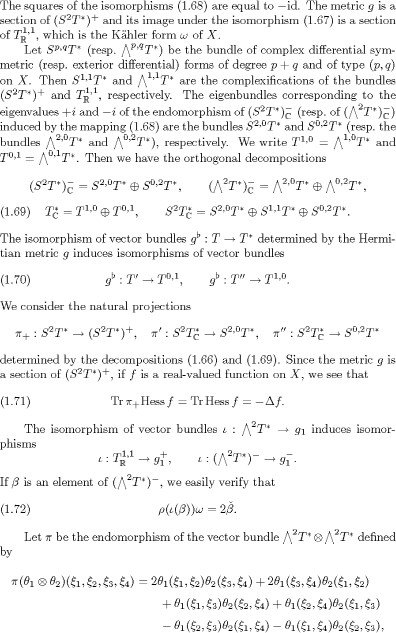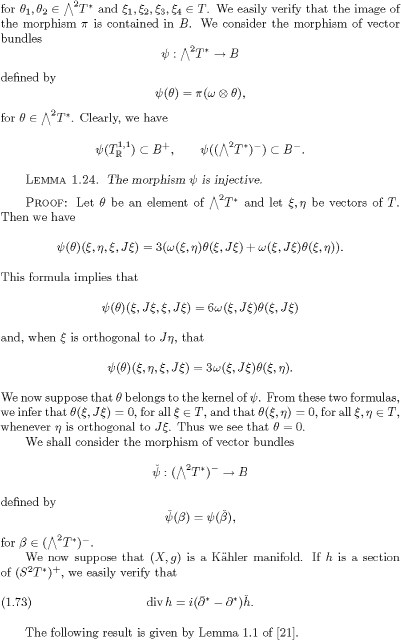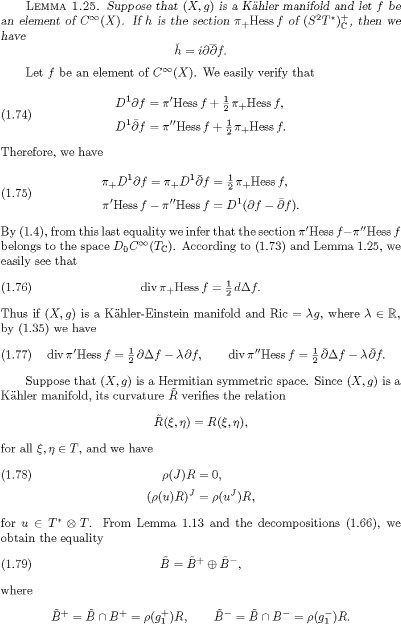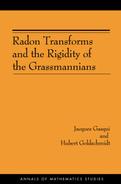CHAPTER I
SYMMETRIC SPACES AND EINSTEIN MANIFOLDS
![]() 1. Riemannian manifolds
1. Riemannian manifolds
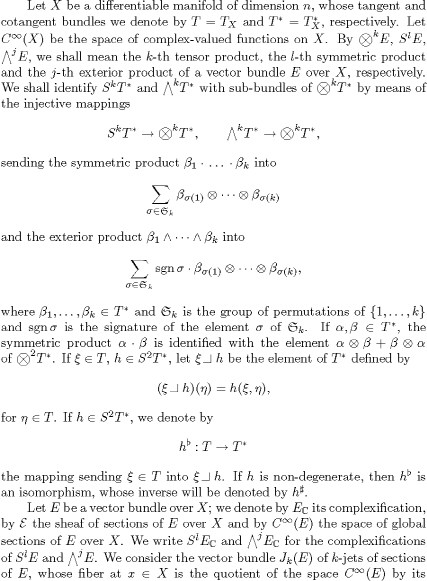
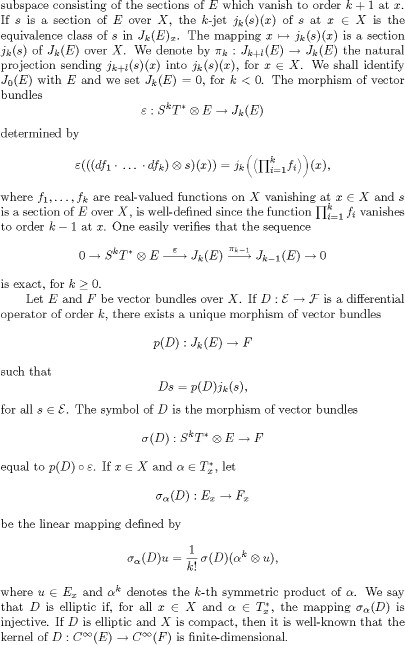
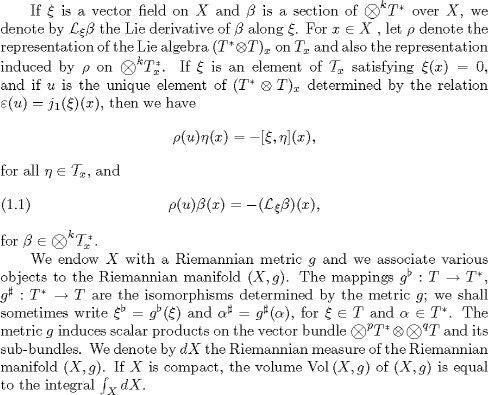
Let E and F be vector bundles over X endowed with scalar products and D : ![]() E F be a differential operator of order k. We consider the scalar products on
E F be a differential operator of order k. We consider the scalar products on ![]() (E) and
(E) and ![]() (F), defined in terms of these scalar products on E and F and the Riemannian measure of X, and the formal adjoint
(F), defined in terms of these scalar products on E and F and the Riemannian measure of X, and the formal adjoint ![]() , which is a differential operator of order k. If D is elliptic and X is compact, then D
, which is a differential operator of order k. If D is elliptic and X is compact, then D![]() (E) is a closed subspace of
(E) is a closed subspace of ![]() (F) and we have the orthogonal decomposition
(F) and we have the orthogonal decomposition
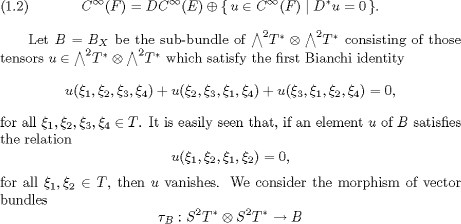
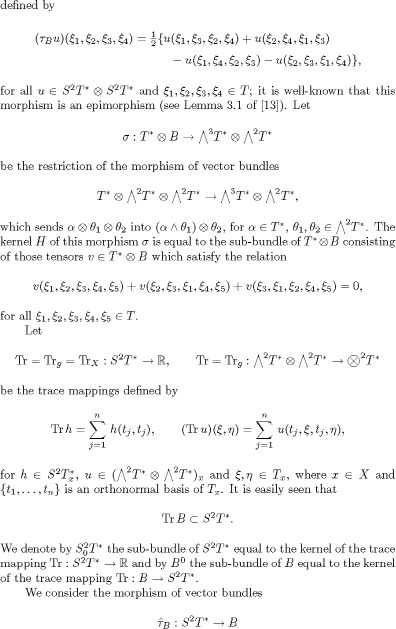
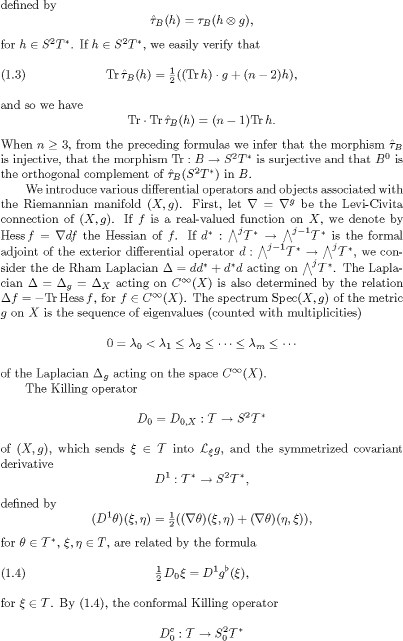
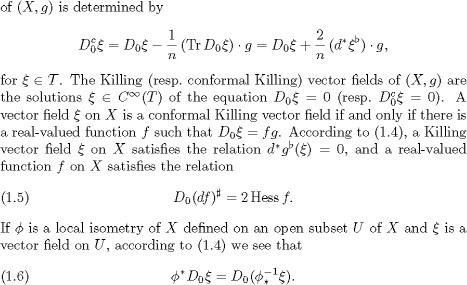
LEMMA 1.1. Let Y be a totally geodesic submanifold of the Rieman-nian manifold (X, g). Let i : Y X be the natural imbedding
and ![]() be the Riemannian metric on Y induced by g. Let
be the Riemannian metric on Y induced by g. Let![]() be a vector field on X. If
be a vector field on X. If![]() is the vector field on Y whose value at x
is the vector field on Y whose value at x ![]() Y is equal to the orthogonal projection of
Y is equal to the orthogonal projection of ![]() onto the subspace TY,x of Tx, then we have
onto the subspace TY,x of Tx, then we have
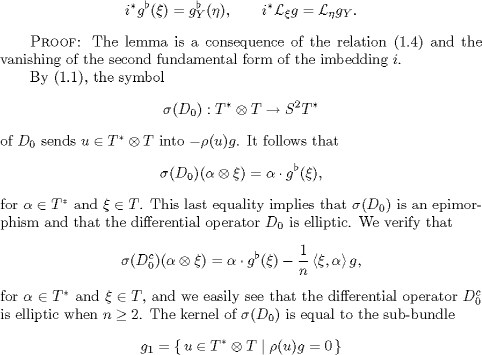
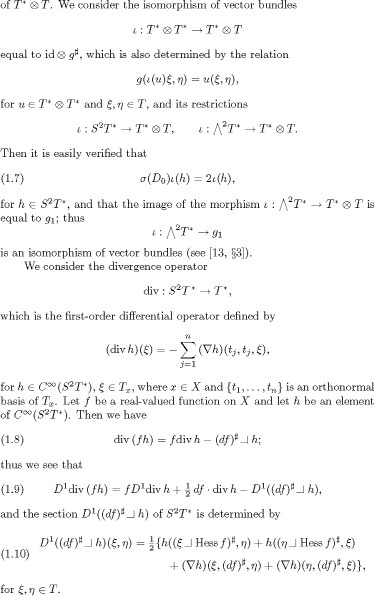
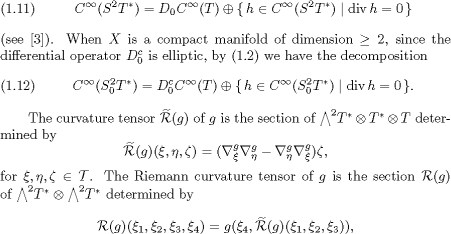
Let ![]() be a vector field on X. According to the second Bianchi identity and the relation (1.4), we see that
be a vector field on X. According to the second Bianchi identity and the relation (1.4), we see that
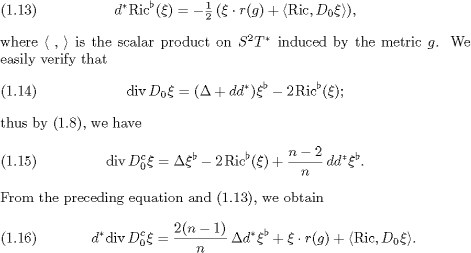
If the scalar curvature r(g) of (X, g) is constant and equal to ![]() and if is a conformal Killing vector field, then by (1.16) we see that the real-valued function f =−(2/n)
and if is a conformal Killing vector field, then by (1.16) we see that the real-valued function f =−(2/n) ![]() dsatisfying
dsatisfying ![]() fg is a solution of the equation
fg is a solution of the equation
![]()
If X is compact, we know that the eigenvalues of the Laplacian![]() acting on
acting on ![]() C(X) are
C(X) are![]() 0; hence from the previous observation, we obtain the following result due to Lichnerowicz [43, 83]:
0; hence from the previous observation, we obtain the following result due to Lichnerowicz [43, 83]:

be the linear differential operators, which are the linearizations along g of the non-linear operators h R(h), h (DR)(h) and
h Ric(h), respectively, where h is a Riemannian metric on X. Let h be a section of ![]()


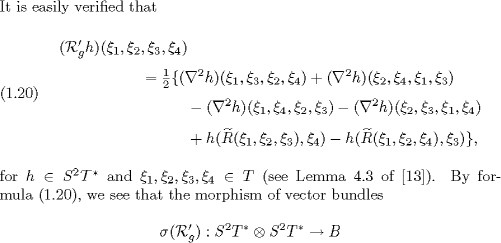
is equal ![]() .
.
The following result is given by Proposition 4.1 of [13].
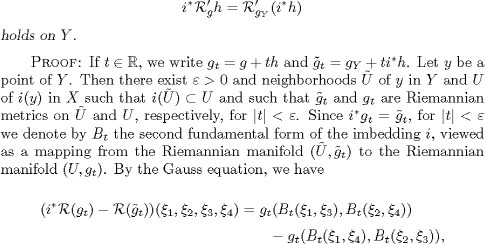
for all ![]() According to our hypothesis, we have B0 = 0; thus if we differentiate both sides of the above equation with respect to t, at t = 0, we obtain
According to our hypothesis, we have B0 = 0; thus if we differentiate both sides of the above equation with respect to t, at t = 0, we obtain

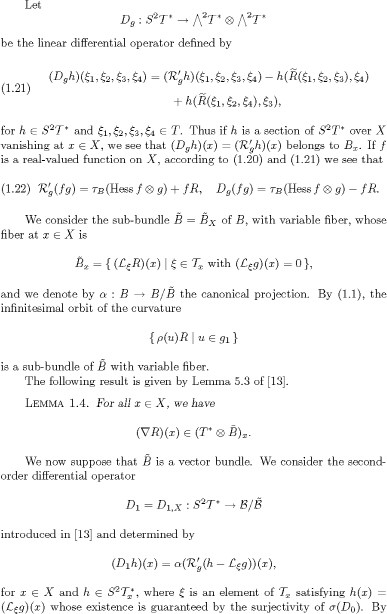

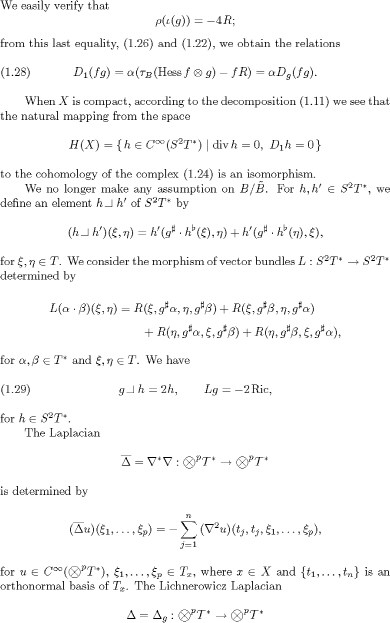
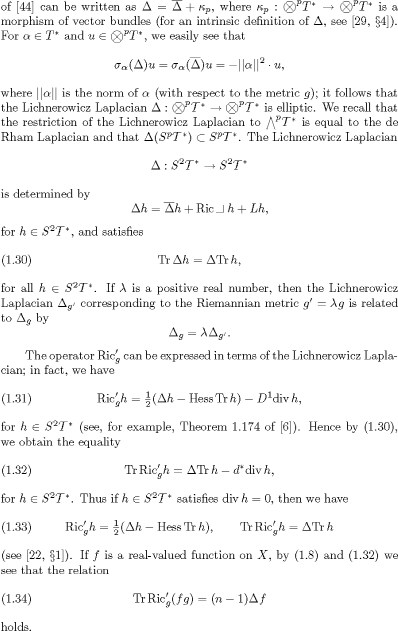
![]() 2. Einstein manifolds
2. Einstein manifolds
We say that the Riemannian manifold (X, g) is an Einstein manifold if there is a real number ![]() such that Ric = g. In this section, we suppose that g is an Einstein metric, i.e., that there is a real number
such that Ric = g. In this section, we suppose that g is an Einstein metric, i.e., that there is a real number ![]() such that Ric =
such that Ric =![]() the scalar curvature r(g) of (X, g) is constant and equal to
the scalar curvature r(g) of (X, g) is constant and equal to ![]() . By (1.29), we have
. By (1.29), we have
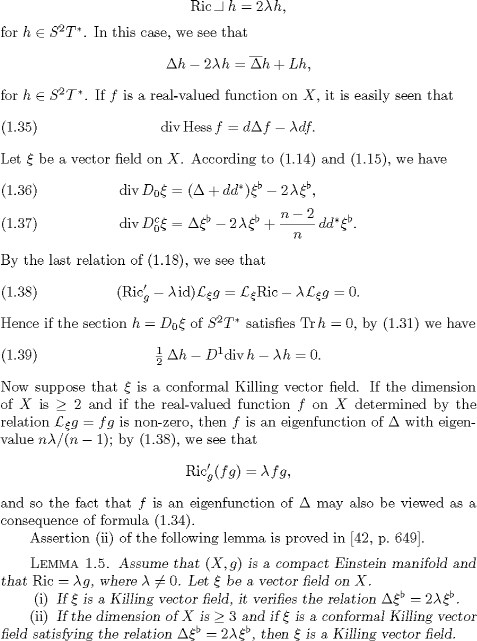


PROOF: Let h be a section of ![]() over X. If x
over X. If x![]() X and h(x) = 0, then by (1.20) and (1.21) we have
X and h(x) = 0, then by (1.20) and (1.21) we have
![]()
If![]() is a vector field on X, then we know that
is a vector field on X, then we know that ![]() = 0; on the other hand, by the last relation of (1.18), we know that (1.38) holds. If x X, by the surjectivity of (D0) we
know that there exists a vector field
= 0; on the other hand, by the last relation of (1.18), we know that (1.38) holds. If x X, by the surjectivity of (D0) we
know that there exists a vector field ![]() on X such that
on X such that ![]() The commutativity of the diagram (1.40) is now a consequence of the previous observations.
The commutativity of the diagram (1.40) is now a consequence of the previous observations.

The proof of Lemma 1.9 can be found in [3,![]() 7]. The following lemma is a generalization of Proposition 3.2 of [22].
7]. The following lemma is a generalization of Proposition 3.2 of [22].
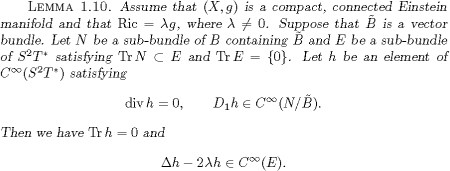
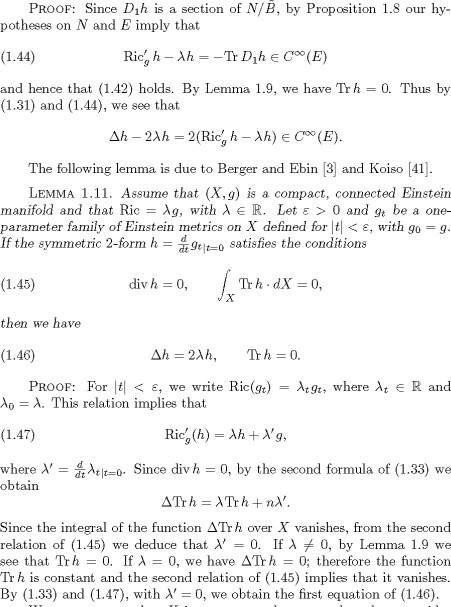
![]()
(see also Koiso [41]). By definition, the space E(X) is contained in an eigenspace of the Lichnerowicz Laplacian ![]() , which is an elliptic operator, and is therefore finite-dimensional.
, which is an elliptic operator, and is therefore finite-dimensional.
According to Lemma 1.7, when ![]() is a vector bundle, we may take N =
is a vector bundle, we may take N = ![]() and E = {0} in Lemma 1.10; from the latter lemma and the relation between the space H(X) and the cohomology of the sequence
(1.24), we obtain the following result:
and E = {0} in Lemma 1.10; from the latter lemma and the relation between the space H(X) and the cohomology of the sequence
(1.24), we obtain the following result:
![]() 3. Symmetric spaces
3. Symmetric spaces
We say that the Riemannian manifold (X, g) is a locally symmetric space if ![]() R = 0. According to Lemma 1.4, if the equality
R = 0. According to Lemma 1.4, if the equality
![]()
holds, then the manifold (X, g) is locally symmetric. Throughout this section, we shall suppose that the manifold (X, g) is
a connected locally symmetric space. Since the set of local isometries of X acts transitively on X, we see that ![]() is a vector bundle. According to [13], the infinitesimal orbit of the curvature is equal to
is a vector bundle. According to [13], the infinitesimal orbit of the curvature is equal to ![]() and so we have:
and so we have:
LEMMA 1.13. Suppose that (X, g) is a connected locally symmetric space. Then ![]() is a vector bundle equal to the infinitesimal orbit of the curvature
is a vector bundle equal to the infinitesimal orbit of the curvature

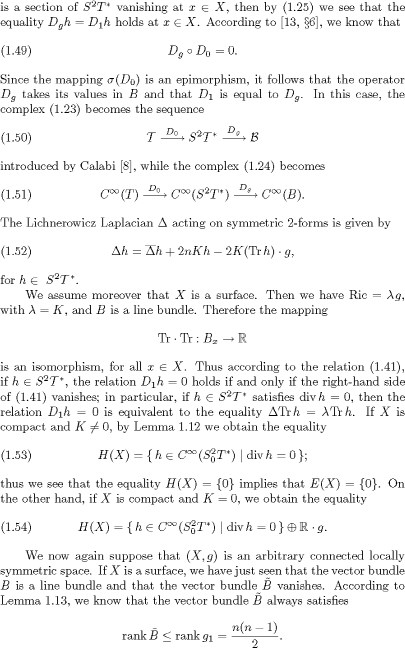
If the dimension of X is ![]() 3, in 1 we saw that TrB =
3, in 1 we saw that TrB = ![]() , and so we obtain the inequalities
, and so we obtain the inequalities

Thus we see that, if the dimension of X is ![]() 2, the vector bundle
2, the vector bundle ![]() is always non-zero.
is always non-zero.
Let Y be a totally geodesic submanifold of X. Let i : Y X be the natural imbedding and gY = ![]() be the Riemannian metric on Y induced by g. Then (Y, gY ) is a locally symmetric space; its Riemann curvature tensor RY is
equal to the section
be the Riemannian metric on Y induced by g. Then (Y, gY ) is a locally symmetric space; its Riemann curvature tensor RY is
equal to the section ![]() of BY and the infinitesimal orbit of Y is equal to
of BY and the infinitesimal orbit of Y is equal to ![]() . For x
. For x![]() Y , the diagram
Y , the diagram
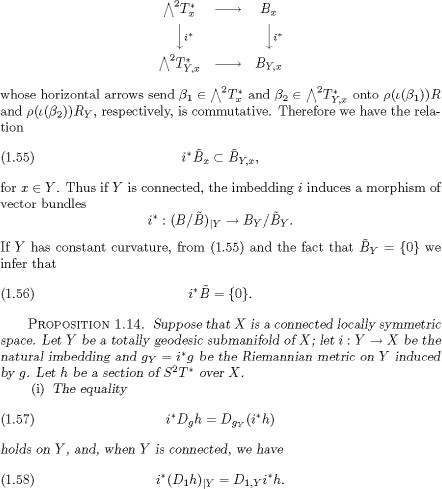
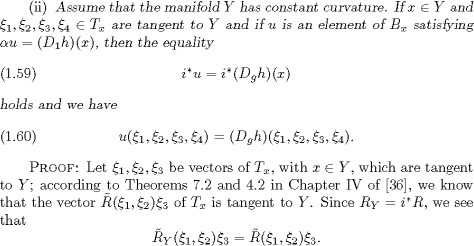
The equality (1.57) now follows from Proposition 1.3 and formula (1.21). Now suppose that Y is connected and let h be a section
of ![]() . Let x be a point of Y and let
. Let x be a point of Y and let ![]() u be an element of Bx satisfying u = (D1h)(x). First, suppose that h vanishes at the point x of Y . Then (Dgh)(x) is an element
of Bx; by (1.25) and (1.58), we see that the vector u - (Dgh)(x) of Bx belongs to
u be an element of Bx satisfying u = (D1h)(x). First, suppose that h vanishes at the point x of Y . Then (Dgh)(x) is an element
of Bx; by (1.25) and (1.58), we see that the vector u - (Dgh)(x) of Bx belongs to ![]() and that
and that
![]()
LEMMA 1.15. Assume that (X, g) is a connected locally symmetric space. Let Y be a totally geodesic submanifold of X of constant
curvature. Let h be a section of ![]() over X. Let x
over X. Let x![]() Y and u be an element of Bx such that (D1h)(x) =
Y and u be an element of Bx such that (D1h)(x) =![]() If the restriction of h to the submanifold Y is a Lie derivative of the metric on Y induced by g, then the restrictions
of Dgh and u to the submanifold Y vanish.
If the restriction of h to the submanifold Y is a Lie derivative of the metric on Y induced by g, then the restrictions
of Dgh and u to the submanifold Y vanish.
PROOF: Let i : Y X be the natural imbedding and gY = ![]() be the Riemannian metric on Y induced by g. Assume that the restriction
be the Riemannian metric on Y induced by g. Assume that the restriction ![]() of h to the submanifold Y is equal to the Lie derivative
of h to the submanifold Y is equal to the Lie derivative ![]() of gY along a vector field
of gY along a vector field ![]() on Y . Since Y has constant curvature, by (1.49) and (1.57) we have
on Y . Since Y has constant curvature, by (1.49) and (1.57) we have
![]()
From Proposition 1.14,(ii) and (1.59), we infer that ![]() iu = 0.
iu = 0.
From Lemmas 1.1 and 1.15, we deduce the following result:
LEMMA 1.16. Assume that (X, g) is a connected locally symmetric space. Let Y , Z be totally geodesic submanifolds of X; suppose
that Z is a submanifold of Y of constant curvature. Let ![]() be a section of
be a section of ![]() over X. Let x
over X. Let x![]() Z and u be an element of Bx such that (D1h)(x) =
Z and u be an element of Bx such that (D1h)(x) = ![]() If the restriction of h to the submanifold Y is a Lie derivative of the metric on Y induced by g, then the restriction of
If the restriction of h to the submanifold Y is a Lie derivative of the metric on Y induced by g, then the restriction of
![]() u to the submanifold Z vanishes.
u to the submanifold Z vanishes.
We consider the third-order differential operator
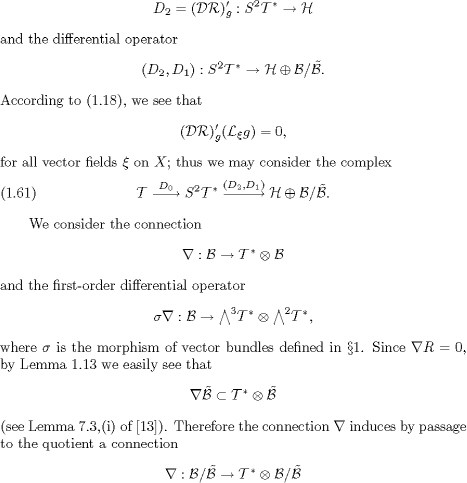
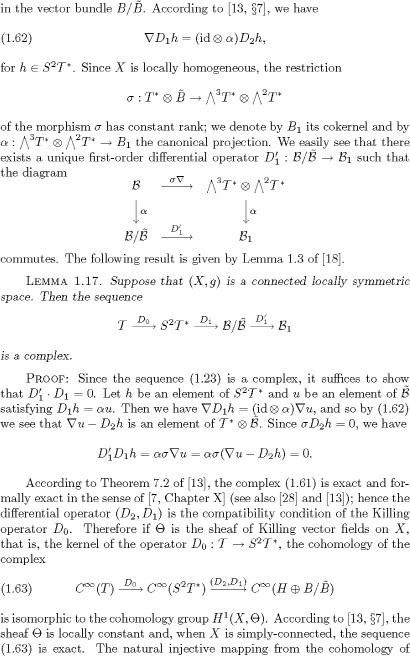
the complex (1.63) to the cohomology of the sequence (1.24) induces an injective mapping from the cohomology group ![]() to the cohomology of the complex (1.24).
to the cohomology of the complex (1.24).
According to Theorem 7.3 of [13], if the equality (1.48) holds, a section h of ![]() satisfying D1h = 0 also satisfies the equation D2h = 0. Therefore if (1.48) is true, the complex (1.23) is exact and the two
mappings considered above involving cohomology groups are isomorphisms. Moreover, if the equality (1.48) holds and X is simply-connected,
the sequence (1.24) is exact; on the other hand, if the equality (1.48) holds and X is compact, the cohomology group (
satisfying D1h = 0 also satisfies the equation D2h = 0. Therefore if (1.48) is true, the complex (1.23) is exact and the two
mappings considered above involving cohomology groups are isomorphisms. Moreover, if the equality (1.48) holds and X is simply-connected,
the sequence (1.24) is exact; on the other hand, if the equality (1.48) holds and X is compact, the cohomology group (![]() is isomorphic to H(X).
is isomorphic to H(X).
THEOREM 1.18. Suppose that (X, g) is a connected locally symmetric space satisfying one of the following conditions:
(ii) (X, g) is a symmetric space of compact type.
Then the sequence (1.63) is exact. If the equality (1.48) holds, the sequence (1.24) is also exact.
We now suppose that (X, g) has constant curvature K; then the vector bundle ![]() vanishes and so the equality (1.48) holds. Thus the complex (1.50) is exact. If X is simply-connected, the sequence (1.51)
is also exact. These two results were first proved by Calabi [8] (see also [2]); other direct proofs are given in [13,
vanishes and so the equality (1.48) holds. Thus the complex (1.50) is exact. If X is simply-connected, the sequence (1.51)
is also exact. These two results were first proved by Calabi [8] (see also [2]); other direct proofs are given in [13,![]() 6]. Furthermore if (X, g) is a compact surface of constant curvature K, from the equalities (1.53) and (1.54) we obtain the
following proposition, whose first assertion is given by [2, p. 24].
6]. Furthermore if (X, g) is a compact surface of constant curvature K, from the equalities (1.53) and (1.54) we obtain the
following proposition, whose first assertion is given by [2, p. 24].
PROPOSITION 1.19. Let (X, g) be a compact surface of constant curvature K.

(ii) If K ![]() 0 and the cohomology group
0 and the cohomology group ![]() vanishes, then we have E(X) = {0}.
vanishes, then we have E(X) = {0}.
We now suppose that X is equal to the sphere (Sn, g0) of constant curvature 1, which is a symmetric space of compact type.
We know that the sequences (1.24) and (1.51) are exact and that the cohomology groups ![]() and H(X) vanish. When X is equal to the sphere (S2, g0), according to Proposition 1.19,(i) and the decomposition (1.12) we
see that
and H(X) vanish. When X is equal to the sphere (S2, g0), according to Proposition 1.19,(i) and the decomposition (1.12) we
see that

where ![]() is a vector field and f is a real-valued function on X = S2. Moreover, by Proposition 1.19,(ii), we have E(X) = {0} when X
= S
is a vector field and f is a real-valued function on X = S2. Moreover, by Proposition 1.19,(ii), we have E(X) = {0} when X
= S
2.
If (X, g) is a compact manifold with positive constant curvature, then its universal covering manifold is isometric to![]() where
where ![]() is a positive real number. Thus from Theorem 1.18 and the above results, we obtain the following:
is a positive real number. Thus from Theorem 1.18 and the above results, we obtain the following:
PROPOSITION 1.20. Let (X, g) is a compact manifold with positive constant curvature. Then cohomology group ![]() and the space H(X) vanish, and the sequence (1.51) is exact.
and the space H(X) vanish, and the sequence (1.51) is exact.
We now suppose that (X, g) is a symmetric space of compact type. Then there is a Riemannian symmetric pair (G,K) of compact
type, where G is a compact, connected semi-simple Lie group and K is a closed subgroup of G, such that the space X is isometric
to the homogeneous space G/K endowed with a G-invariant metric. We identify X with G/K, and let x0 be the point of X corresponding
to the coset of the identity element of G in G/K. If ![]() and
and ![]() are the Lie algebras of G and K, respectively, we consider the Cartan decomposition
are the Lie algebras of G and K, respectively, we consider the Cartan decomposition ![]() corresponding to the Riemannian symmetric pair (G,K), where
corresponding to the Riemannian symmetric pair (G,K), where ![]() p0 is a subspace of
p0 is a subspace of ![]() . We identify p0 with the tangent space to X at the point x0. If B is the Killing form of the Lie algebra
. We identify p0 with the tangent space to X at the point x0. If B is the Killing form of the Lie algebra ![]() , the restriction of -B to
, the restriction of -B to ![]() induces a G-invariant Riemannian metric
induces a G-invariant Riemannian metric ![]() on X. According to Theorem 7.73 of [6], we know that
on X. According to Theorem 7.73 of [6], we know that

LEMMA 1.21. Let (X, g) be an irreducible symmetric space of compact type. Then g is an Einstein metric and there is a positive
real number such that Ric =![]() moreover, the metric g0 induced by the Killing form of
moreover, the metric g0 induced by the Killing form of ![]() is equal to
is equal to ![]()
In [41] and [42], Koiso proved the following:
Theorem 1.22. Let X be an irreducible symmetric space of compact type whose universal covering manifold is not equal to one of the following:

Some of the methods used by Koiso to prove Theorem 1.22 will be described in ![]() Chapter II; in fact, we shall give an outline of the proof of this theorem for an irreducible symmetric space X which is
not equal to a simple Lie group. According to the remarks preceding Theorem 1.18, from Lemma 1.12 and Theorem 1.22 we deduce:
Chapter II; in fact, we shall give an outline of the proof of this theorem for an irreducible symmetric space X which is
not equal to a simple Lie group. According to the remarks preceding Theorem 1.18, from Lemma 1.12 and Theorem 1.22 we deduce:
THEOREM 1.23. Let X be an irreducible symmetric space of compact type whose universal covering manifold is not equal to one of the spaces (i)–(v) of Theorem 1.22. Then the sequence (1.24) is exact.
In [13] and [10], the equality (1.48) is proved for the complex projective space ![]() with n 2, and the complex quadric of dimension
with n 2, and the complex quadric of dimension![]() 3 (see Propositions 3.32 and 5.14). Thus from Theorem 1.18, without the use of the space of infinitesimal Einstein deformations,
we obtain the exactness of the sequence (1.24) when X is an irreducible symmetric space of compact type equal either to a
sphere, to a real or complex projective space, or to the complex quadric of dimensio
3 (see Propositions 3.32 and 5.14). Thus from Theorem 1.18, without the use of the space of infinitesimal Einstein deformations,
we obtain the exactness of the sequence (1.24) when X is an irreducible symmetric space of compact type equal either to a
sphere, to a real or complex projective space, or to the complex quadric of dimensio![]() n 3. Theorem 1.23 also gives us the exactness of the sequence (1.24) for these irreducible symmetric spaces other than the
complex quadric of dimension 4. In fact, we conjecture that the equality (1.48) holds for any irreducible symmetric space.
n 3. Theorem 1.23 also gives us the exactness of the sequence (1.24) for these irreducible symmetric spaces other than the
complex quadric of dimension 4. In fact, we conjecture that the equality (1.48) holds for any irreducible symmetric space.
![]() 4. Complex manifolds
4. Complex manifolds
In this section, we suppose that X is a complex manifold endowed with a Hermitian metric g. We consider the sub-bundles ![]() Tand
Tand ![]() Tof TC of complex vector fields of type (1, 0) and (0, 1), respectively; then we have the decomposition
Tof TC of complex vector fields of type (1, 0) and (0, 1), respectively; then we have the decomposition


